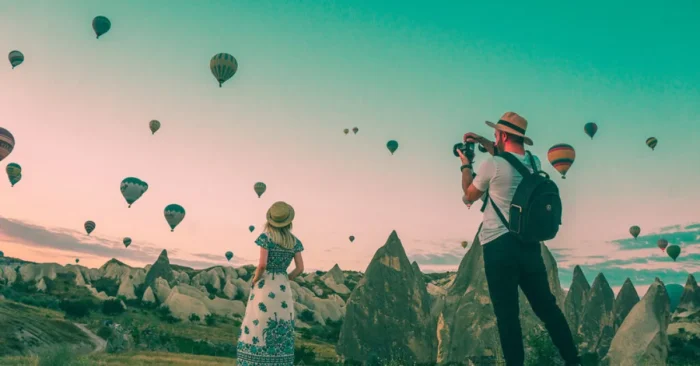Overview
AI tools for travel vlogs help creators capture, edit, and share their adventures more easily and professionally. These tools assist with video editing, color grading, sound enhancement, script writing, translation, and optimizing content for YouTube, Instagram, or TikTok. By automating repetitive and technical tasks, AI frees up vloggers to focus on storytelling and exploration. Whether you travel solo or with a team, AI tools can speed up post-production, improve video quality, and increase viewer engagement. With these tools, travel vloggers can produce polished content faster, reach wider audiences, and build their brand more effectively.
1. AI for Video Editing Automation
AI video editors (e.g. Adobe Premiere Pro’s Sensei, Descript) help automatically trim clips, remove pauses, sync music, add transitions, and suggest B-roll or stock footage. Instead of manually cutting hours of footage, travel vloggers can use AI to generate rough cuts which greatly reduce editing time. These tools often include scene detection to identify the best shots—sunsets, action scenes, or wide landscapes—and align them to music beats. The result: a more professional, cohesive vlog with less editing frustration.
2. Script & Caption Generation
AI writing tools like ChatGPT, Jasper, or Copy.ai help vloggers write compelling scripts, catchy intros, and YouTube descriptions. They can also generate subtitles and captions automatically, improving accessibility and viewer retention. For travel content where audience may come from different languages, accurate captions broaden reach. Additionally, AI can optimize titles and descriptions for search engine results (SEO) and suggest trending tags. This ensures the vlog is discoverable while still reflecting the creator’s voice and story.
3. Color Grading & Visual Enhancement
AI-powered color tools (e.g. DaVinci Resolve’s Auto Color, Colorlab, or Luminar) help improve the look of footage by balancing lighting, correcting colors, enhancing skies, and stabilizing shaky shots. When traveling, lighting and weather conditions vary greatly; AI tools can standardize the visual tone across clips. This consistency makes travel vlogs look more polished and cinematic. Automated visual enhancements also help in night shots, underwater footage, or drone footage where manual adjustment would be tedious.
4. Sound & Music Suggestions
Good audio can make or break a travel vlog. AI tools can clean audio, reduce background noise, level volume, and even remove wind or traffic noise. They also suggest fitting royalty-free tracks or sound effects based on mood and pacing. AI like Adobe Audition’s noise reduction, Auphonic, or tools that detect mood in scenes can make suggestions that match the visuals. Balanced audio helps retain viewers and gives a more immersive experience.
5. Automated Subtitle Translation
Travel vloggers often have global audiences. AI tools translate subtitles into multiple languages automatically, ensuring more people understand the content. Some tools go further, localizing phrasing, tone, or cultural references. Automatically synced subtitles not only make content inclusive but also improve watch time and engagement from non-native speakers. This widens reach and opens opportunities for international monetization or sponsorship.
6. Thumbnail & Graphic Design
AI tools like Canva AI, Adobe Firefly, or Snappa generate attention-grabbing thumbnails and branded graphics. Thumbnails are often the first impression for potential viewers, so compelling visuals matter. AI can suggest layout, fonts, color contrast, and imagery based on subject matter (beaches, mountains, cityscapes). Graphic consistency across vlog thumbnails helps build brand recognition. Good design can increase click-through rates and overall viewer growth.
7. Travel Planning & Location Insights
Some AI tools assist in planning travel vlogs by suggesting destinations, travel routes, and content ideas based on trends and audience interests. They analyze what types of destinations, experiences, or scenery are currently popular and suggest video concepts. AI might even forecast weather or crowd predictions to help choose filming times. Pre-planning with AI ensures more engaging and relevant content, reduces wasted footage, and helps vloggers capture unique scenes.
8. Drone Footage Stabilization & Effects
Drone shots add cinematic quality but can suffer from shakiness, wind, or lighting shifts. AI tools help stabilize, correct perspective, reduce distortion, and enhance aerial footage. Some also suggest cinematic drone movements or auto-zoom based on scene. These enhancements turn raw drone clips into polished cinematic sequences, improving storytelling and viewer experience without requiring manual editing expertise.
9. Analytics & Audience Insights
AI tools analyze viewer retention, drop-off points, watch time, and engagement metrics. They indicate which parts of vlogs are most engaging and suggest improvements for future videos. They also track geographic data, which content performs best in which regions, optimal upload times, and even topic popularity. With this information, travel vloggers can refine content direction, invest in what works, and grow their audience strategically rather than guessing what viewers want.
10. Automation of Publishing & Sharing
AI tools help schedule video uploads, cross-post content snippets to social media, automate posting of teaser clips, and optimize posting times. For example, tools can generate short vertical clips for Instagram/Reels or TikTok from longer vlogs. Automation reduces repetitive tasks of manually resizing, formatting, or writing similar posts for different platforms. Travel vloggers save time and maintain consistent online presence.
(FAQs)
Q1: Do AI tools reduce originality of travel vlogs?
No. AI tools assist with technical and repetitive work, but your voice, storytelling style, choice of scenes, and perspective remain unique. Use AI to enhance, not replace, originality.
Q2: Are AI video tools expensive for travel vloggers?
Some are premium with advanced features, but many tools offer free tiers or pay-as-you-go options. You can start small and scale up as your audience grows.
Q3: Can AI tools work offline or while traveling without strong internet?
Many video editing tools require cloud access for AI features, but some (like local apps with AI built in) or mobile apps offer offline modes. It’s best to plan ahead and download required assets or preset templates.
Learn More About AI Course https://buhave.com/courses/learn/ai/
















